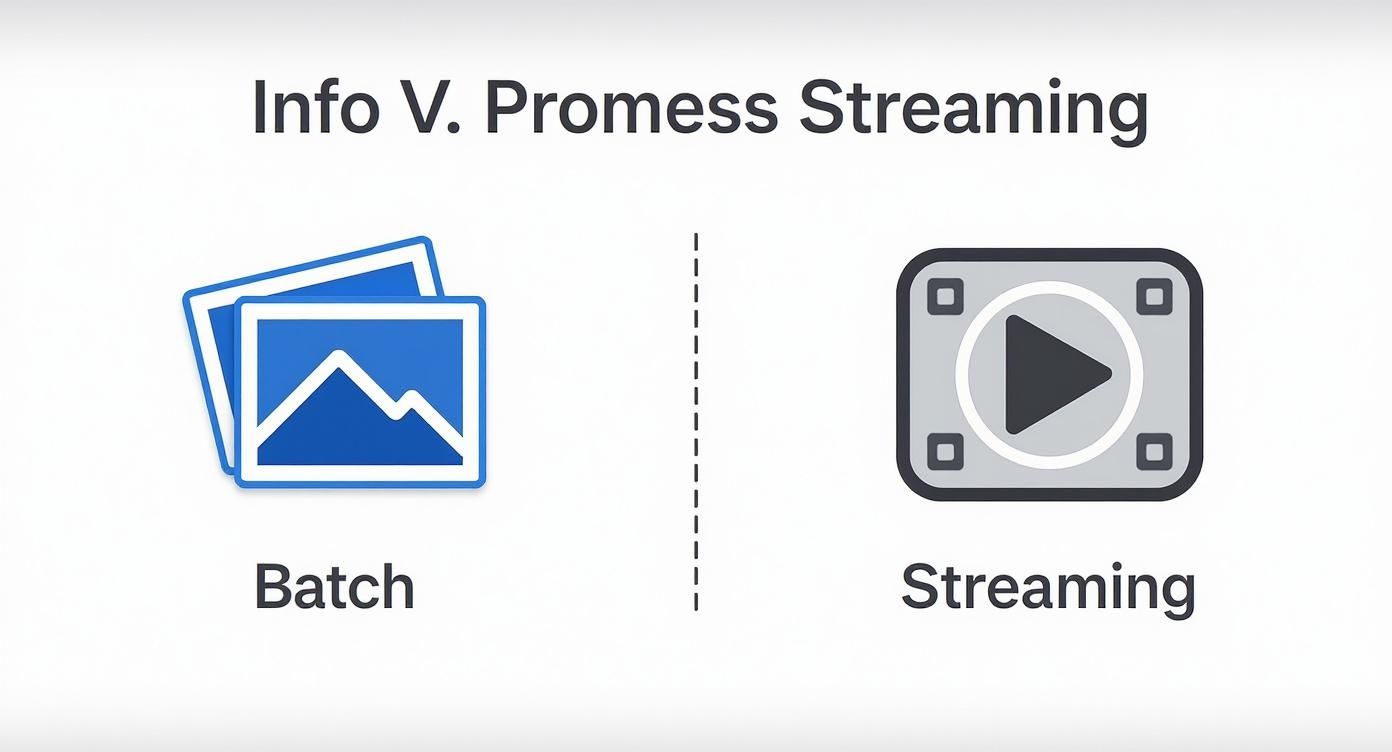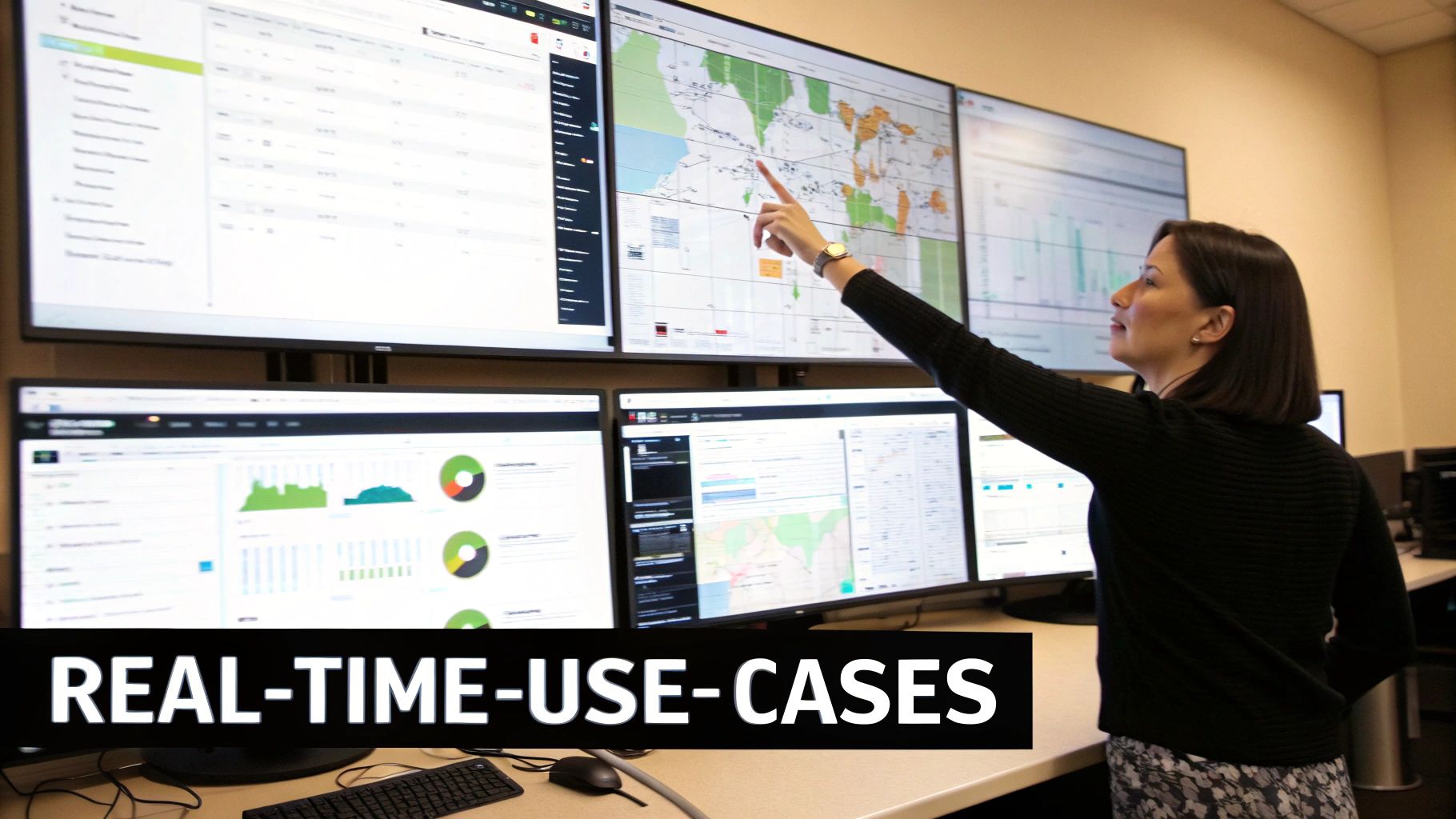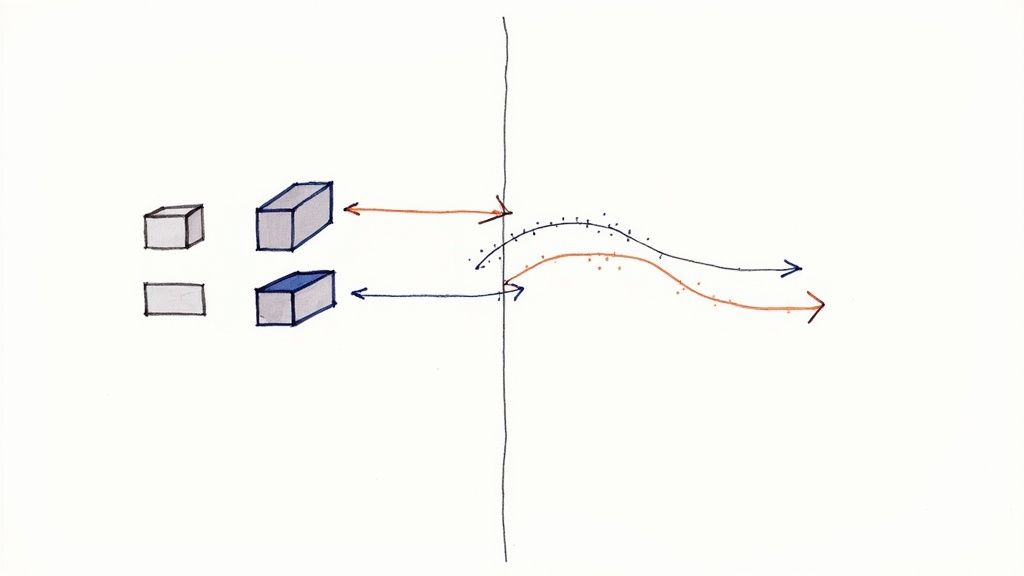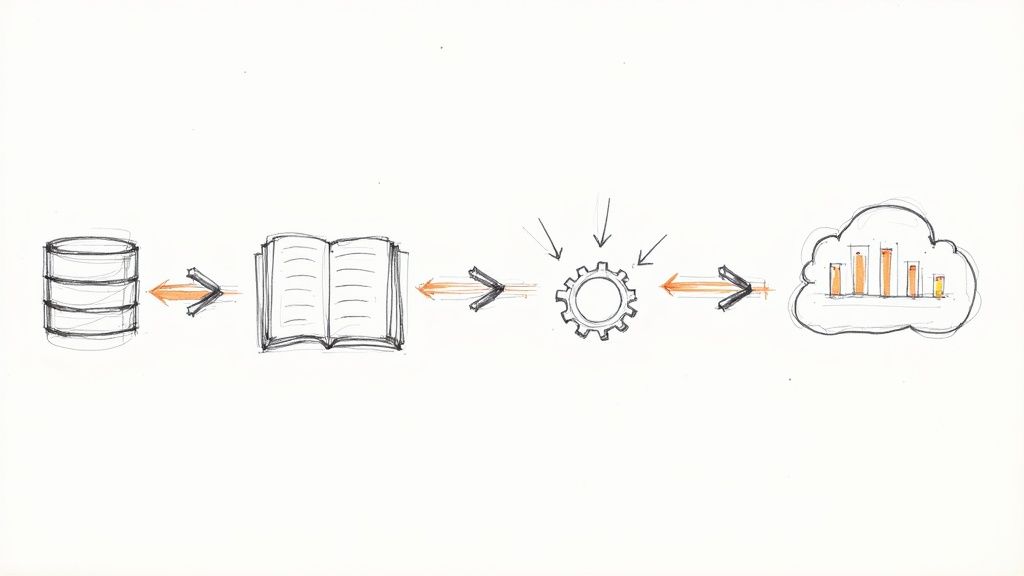Streaming Data Platform: Real-Time Insights for Businesses
Explore how a streaming data platform delivers real-time insights and powers agile decision-making for modern businesses.
A streaming data platform is the engine that lets you work with data while it’s still in motion. It's built to ingest, process, and analyze a constant flow of information, allowing a business to react the second something happens, not hours or days later.
Understanding the Core Concept
Think about trying to understand a city's traffic by only looking at a photo taken once every hour. You'd get a general sense of things, sure, but you'd miss the whole story. You wouldn't see the sudden fender-bender causing a jam or the immediate gridlock from a broken traffic light. That's how traditional data analysis, or batch processing, works—it's always looking at the past.
A streaming data platform, on the other hand, is like having a live video feed from every traffic camera in the city. It's a complete system that catches an endless stream of data—what we call events—as they happen. This gives you the power to see patterns emerge, fix problems instantly, and make decisions with information that’s literally seconds old.
What Are Data Events?
In the world of streaming, an "event" is simply a record of something that happened. These are the tiny, individual signals that, when you see them all together, paint a very detailed picture.
Here are a few common examples of data events:
- A customer clicks "Add to Cart" on an online store.
- A sensor on a factory floor reports its current temperature.
- A user presses "play" on a video streaming app.
- A GPS tracker in a delivery van sends a location update.
Each of these is just one small piece of the puzzle. A streaming data platform is designed to handle millions, or even billions, of these events every second. It catches them, organizes them, and makes sense of them on the fly. To get a better handle on the basics, you can check out our guide on what is streaming data.
A streaming data platform moves businesses from a reactive stance, where they analyze the past, to a proactive one, where they can influence the present. It’s the difference between reading a history book and watching the news live.
Instead of waiting for data to land in a database before running a query, this approach processes the data as it travels through the system. This fundamental shift makes it possible to build incredibly responsive applications. For example, a bank can spot a fraudulent transaction in milliseconds and stop it, rather than just discovering the theft in a report the next day. That immediate, preventative power is what a modern streaming data platform is all about.
How a Streaming Architecture Works
A streaming data platform isn't just one piece of software; it's a whole ecosystem of components working together. I like to think of it as a modern factory assembly line—raw materials (data) go in one end, get processed at different stations, and a finished product (insight) comes out the other, all in a continuous flow.
This real-time digital factory is the core of a streaming architecture. Each stage has a critical job, and if one part breaks down or even just slows down, the entire production line feels the impact. To really get a handle on how this all delivers value in the moment, we need to look at the four essential stages that make it all tick.
The infographic below really drives home the difference between the old way of doing things (batch processing) and the modern streaming approach.

It’s the difference between looking at a series of static photos versus watching a live video feed. One tells you what happened; the other shows you what's happening right now.
The Four Pillars of a Streaming Data Platform
Let's break down that "assembly line" into its functional parts to see what's happening under the hood. Every component handles the data at a different point in its journey, making sure it moves from a raw signal to a useful insight without any frustrating delays.
For a deeper comparison of the two methodologies, our guide on batch vs. stream processing is a great resource.
The table below outlines the core components that form the foundation of any modern streaming platform. Think of them as the fundamental building blocks.
The Four Pillars of a Streaming Data Platform
ComponentPrimary FunctionCommon TechnologiesData IngestionThis is the entry point. Its job is to capture raw data streams from sources like apps, IoT sensors, or databases as events happen.Connectors, Agents, SDKsData TransportThink of this as the high-speed conveyor belt. It moves massive streams of event data reliably and quickly between all the other components.Apache Kafka, Amazon KinesisStream ProcessingThis is the "brain" of the operation. Here, data is transformed, analyzed, and enriched on the fly, in real time.Apache Flink, ksqlDBData StorageThe final stop. This is where processed insights and raw events land, optimized for quick access and deeper analysis.Data Warehouses, Data Lakes
This tightly integrated structure ensures that data isn't just piling up somewhere; it's being put to work the instant it's created.
Just as a factory can’t produce cars without a reliable way to move parts from one station to the next, a streaming data platform relies on its transport layer to guarantee data reaches its destination without loss or delay.
A Step-by-Step Data Flow
So, what does this look like in the real world? Let’s walk through a familiar example: a ride-sharing app.
- Ingestion: The moment you request a ride, your app generates an event. A connector immediately captures this event—your location, destination, user ID—and pushes it into the platform. It's the first handshake.
- Transport: That event is then published to a distributed log like Apache Kafka. This system acts as a durable, high-throughput buffer, making sure the data is never lost even if other systems downstream are temporarily offline.
- Processing: A stream processing engine like Apache Flink is constantly listening. It reads the ride request event from Kafka and, in milliseconds, might join it with other real-time data streams, like current traffic conditions and driver availability, to calculate your fare and ETA.
- Storage: The result of that calculation is sent to two places at once. The immediate answer (your price and arrival time) is sent straight back to your app. At the same time, the raw event data is archived in a data warehouse like Snowflake for the company to analyze ridership trends later.
This entire sequence happens in the blink of an eye, showcasing the power of a well-orchestrated streaming data platform. Each component plays its part, working in perfect sync to turn a simple tap on your phone into a complex, data-driven action.
The Business Impact of Real-Time Data
So, why is everyone suddenly talking about moving from old-school batch processing to a real-time streaming model? It's about more than just speed—it’s a complete overhaul of how a business operates, competes, and ultimately creates value. When you bring a streaming data platform into the mix, you're unlocking a whole new level of strategic thinking.
The biggest win is getting immediate insights that fuel faster, smarter decisions. Instead of digging through last week's data to figure out what went wrong, your teams can spot opportunities and squash problems the second they pop up. This shift from looking in the rearview mirror to looking at the road ahead is a massive competitive advantage.
Driving Proactive Business Operations
Think about the world of finance, where a split-second delay can mean the difference between stopping fraud and cleaning up a costly mess. A streaming platform can instantly analyze transaction events as they happen, flagging suspicious activity by cross-referencing it with known patterns in milliseconds. That's how a bank can block a sketchy purchase before the transaction even goes through.
Or take manufacturing. A streaming platform can continuously monitor data from IoT sensors attached to factory machinery. If a sensor picks up an unusual temperature spike, it can trigger an instant alert for preventive maintenance. This simple action can help you sidestep a catastrophic equipment failure that would have cost a fortune and halted production.
By processing data in motion, businesses move from a reactive posture—analyzing historical reports—to a proactive one where they can shape outcomes in the present moment. This shift is crucial for staying ahead in a competitive market.
Enhancing Customer Experiences
Another huge benefit of real-time data is the power to create truly personalized customer experiences. Imagine a streaming data platform analyzing a user's clicks, searches, and interactions on your website or app as they happen.
This lets an e-commerce site serve up product recommendations based on what a customer is browsing right now, not what they bought six months ago. That kind of responsiveness makes the experience feel incredibly relevant and intuitive, which is a surefire way to boost engagement and sales. This ability to adapt on the fly is a core driver of modern real-time data analytics.
To truly capitalize on what real-time data can do, you need solid data management and analytics practices in place. The market certainly reflects this demand; the global streaming analytics space was valued at a cool $23.4 billion in 2023 and is on track to hit $128.4 billion by 2030. That kind of growth shows just how seriously companies are taking real-time processing. You can find more details about this explosive market growth on integrate.io.
Streaming Data Platforms in Action

Theory is great, but seeing how streaming data platforms work in the real world is where it all starts to make sense. These platforms are the invisible workhorses behind many of the instant, personalized services we now take for granted. They're constantly churning through massive flows of event data to give us immediate, useful responses.
From protecting our bank accounts to curating our shopping feeds, the applications are everywhere. Let's look at a few specific examples to see how this technology tackles real business challenges.
Finance: Protecting Assets in Milliseconds
In the world of finance, speed isn't just an advantage; it's a necessity. Banks and fintech firms are constantly swimming in a sea of transactions, and somewhere in that flood are fraudsters trying to make a quick buck. Simply waiting for a daily report to find out you’ve been robbed is a recipe for disaster.
This is where a streaming data platform becomes a non-negotiable tool.
- The Problem: A thief gets ahold of credit card information and immediately starts making a string of online purchases.
- The Solution: The platform pulls in every single transaction the moment it happens. A stream processing engine instantly cross-references the purchase with the user's typical spending habits, location, and known fraud patterns.
- The Outcome: The system flags the suspicious activity in milliseconds, automatically declining the transaction and stopping the theft before any money is lost.
This is the technology that makes things like real-time machine learning fraud detection possible, turning data into an immediate shield. The same principle applies to algorithmic trading, where platforms analyze live market feeds to execute trades at the perfect moment.
E-commerce: Creating Dynamic Customer Experiences
In the fiercely competitive e-commerce space, personalization is the name of the game. A generic website just doesn't cut it anymore. The real goal is to create an experience that feels alive and responds to a shopper's every move.
Streaming data platforms are what make this kind of dynamic, on-the-fly personalization a reality.
By analyzing a user's real-time behavior—what they click, what they search for, and what they add to their cart—an e-commerce site can immediately adjust product recommendations, offer relevant promotions, and ensure inventory levels are accurate.
This turns a static online catalog into a conversation. It's also the engine behind dynamic pricing, allowing retailers to adjust prices based on real-time demand, what competitors are doing, and current stock levels to maximize their revenue.
Entertainment: Powering Seamless Content Delivery
The entire streaming entertainment industry—from video to music—is built on real-time data. When you hit play on a movie, you expect it to start immediately, no buffering. Making that happen for millions of people at once requires an incredibly sophisticated system.
The global video streaming market is a perfect example. It's expected to grow at a CAGR of 21.5% and hit $416.84 billion by 2030, largely driven by live events. A powerful streaming data platform is the only way to support that kind of scale, managing everything from content delivery networks to user analytics. You can read more about these market projections on grandviewresearch.com.
These platforms also fuel the recommendation engines that tell you what to watch next. By looking at your viewing history and what you're doing right now, services can serve up personalized suggestions that keep you hooked, showing just how valuable and versatile streaming data truly is.
How to Choose the Right Platform

Let's be clear: picking a streaming data platform isn't a simple technical task. It's a strategic decision that needs to fit your business goals, your team's skills, and your budget. The platform you land on will become the backbone of your real-time operations, so this is one of those choices you really want to get right from the start.
Think of it like buying a vehicle. You wouldn't buy a sports car to haul construction materials, and you wouldn't use a massive freight truck for a quick trip to the grocery store. Each streaming platform has its own strengths and trade-offs. The trick is matching the tool to the specific job you need done.
To make a smart choice, you have to look past the flashy marketing claims and judge these platforms on a handful of practical, real-world criteria. It means asking yourself some tough questions before you even start looking at vendor websites.
Key Evaluation Criteria
Before you get lost in a sea of technology options, take a step back and define what you actually need. A clear picture of your use case will be your north star, guiding you through a very crowded market. A platform that's brilliant for IoT sensor data might completely fall apart when handling high-frequency financial transactions. The details matter.
Start by asking these foundational questions:
- Scalability: How much data are you really talking about, both today and three years from now? A solid platform should cruise through your peak traffic without a hiccup and grow with you without costing a fortune.
- Latency Requirements: How fast is "real-time" for you? Fraud detection might need sub-second responses, but a dashboard for marketing analytics can probably live with a few seconds of delay. Just remember, chasing lower latency often brings higher costs and complexity.
- Ecosystem Integration: Does the platform play nice with your existing stack? Look for pre-built connectors for your databases, data warehouses, and other tools. Good integration support can save you hundreds of hours in development time.
- Deployment Model: Are you looking for a fully managed cloud service like AWS Kinesis or offerings from Streamkap, where the infrastructure is handled for you? Or do you have an engineering team ready to roll up their sleeves and manage a self-hosted powerhouse like Apache Kafka?
The best streaming data platform isn't the one with the longest feature list. It's the one that's the best fit for your company's specific performance needs, technical skills, and operational reality.
Comparing Platform Philosophies
Different platforms are built on fundamentally different ideas. For example, Apache Kafka has become the gold standard for reliably moving massive volumes of event data—it’s the indestructible conveyor belt. But on its own, Kafka is just the transport layer; you still need a separate tool like Apache Flink to do any of the heavy lifting with stream processing.
On the other hand, you have cloud-native services like Amazon Kinesis. These platforms offer a much more integrated, managed experience, hiding a lot of the operational complexity. This gets you up and running faster, but you trade some control and can risk getting locked into a single vendor, which might get pricey as you scale.
Ultimately, the choice comes down to what your team values more: the granular control and customization of a tool like Kafka, or the speed and simplicity of a managed service.
Common Questions About Streaming Data
Diving into real-time data can feel like learning a new language. It’s a major shift from the old ways of handling information, so it’s natural to have questions. Let's clear up some of the most common ones you’ll run into.
What Is the Main Difference Between Batch and Stream Processing?
The biggest difference boils down to one thing: timing.
Think of batch processing like old-school film photography. You'd take a whole roll of pictures, finish it, then send it off to be developed all at once. It’s the same with data—you collect it over a set period (an hour, a day, a week), then run a big job to process everything in one go.
Stream processing is more like a live video feed. It processes data instantly, event by event, the moment it happens. This immediate feedback is crucial for anything that can't wait, like flagging a fraudulent credit card transaction in the milliseconds before it goes through.
- Batch Processing: Works with large, static chunks of data on a schedule.
- Stream Processing: Works with a never-ending flow of data as it’s created.
Batch is perfect for things like end-of-month financial reports, but streaming is what powers instant fraud alerts, live leaderboards, and interactive apps.
Is a Streaming Data Platform the Same as Apache Kafka?
This is a really common mix-up, and the short answer is no. Apache Kafka is a crucial part of most streaming platforms, but it's not the whole show.
It helps to think of a factory. Kafka is the super-fast, incredibly reliable conveyor belt moving parts from one station to the next. It’s the best in the business at moving massive amounts of data from point A to point B, safely and in order.
A complete streaming data platform is the entire factory. It has the conveyor belt (Kafka), but it also includes all the specialized machinery that processes, transforms, and analyzes the parts as they move along (like stream processors such as Apache Flink). It also has the systems for bringing in raw materials and shipping out finished products.
So, while Kafka is often the central nervous system, a full platform wraps it with connectors, processing engines, and management tools to give you a complete, working solution.
Does My Small Business Need a Streaming Data Platform?
That really depends on what makes your business tick. These platforms aren't just for Silicon Valley giants anymore, but they’re not a one-size-fits-all solution, either.
The key question to ask is: do we gain a real advantage by acting on information that's only seconds old?
If you run an e-commerce store where real-time inventory updates prevent you from overselling popular items, then yes, it could be a game-changer. The same goes for a delivery service that needs to track drivers on a live map.
But if your business runs just fine on daily or weekly reports, the extra complexity and cost might not be worth it just yet. The good news is that managed services have made it much easier for smaller companies to get started, but only when there’s a clear, high-impact reason to do so.
Ready to replace outdated batch ETL with an efficient, real-time streaming solution? Streamkap offers a cutting-edge platform that uses CDC to synchronize your data with minimal latency and zero impact on source databases. Simplify your event-driven architecture and unlock real-time insights by visiting https://streamkap.com to learn more.



